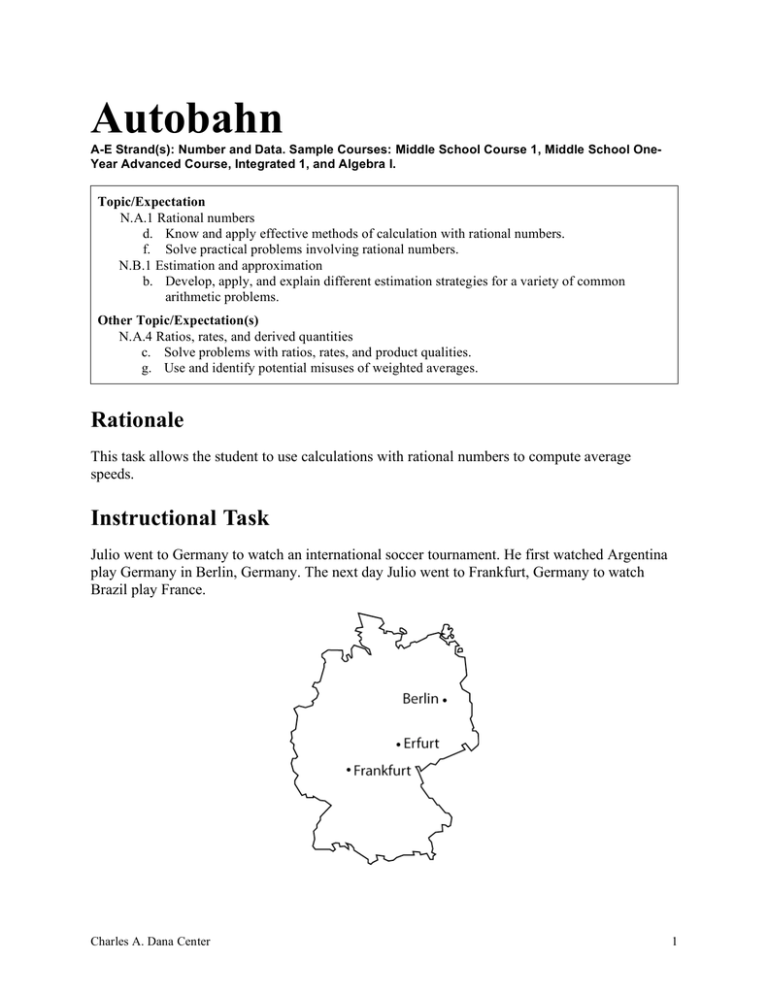Document 11675573
advertisement

Autobahn A-E Strand(s): Number and Data. Sample Courses: Middle School Course 1, Middle School OneYear Advanced Course, Integrated 1, and Algebra I. Topic/Expectation N.A.1 Rational numbers d. Know and apply effective methods of calculation with rational numbers. f. Solve practical problems involving rational numbers. N.B.1 Estimation and approximation b. Develop, apply, and explain different estimation strategies for a variety of common arithmetic problems. Other Topic/Expectation(s) N.A.4 Ratios, rates, and derived quantities c. Solve problems with ratios, rates, and product qualities. g. Use and identify potential misuses of weighted averages. Rationale This task allows the student to use calculations with rational numbers to compute average speeds. Instructional Task Julio went to Germany to watch an international soccer tournament. He first watched Argentina play Germany in Berlin, Germany. The next day Julio went to Frankfurt, Germany to watch Brazil play France. Charles A. Dana Center 1 Autobahn To get from Berlin to Frankfurt for this second game, Julio took a bus from Berlin to Erfurt (303 km); then he rented a car and drove from Erfurt to Frankfurt (254 km). Julio drove on German highways, called autobahns, which have no general speed limit for passenger vehicles; however, buses have an enforced speed limit of 80 km/hr. 1. If the bus drove 80 km/hr from Berlin to Erfurt and Julio drove 130 km/hr from Erfurt to Frankfurt, what was the total amount of time it took Julio to travel from Berlin to Frankfurt? Give your answer to the nearest minute. 2. What percentage of his trip did Julio spend on the bus? In the car? 3. What was Julio’s average speed for the entire trip? 4. If Julio had rented a car and driven from Berlin to Erfurt at 130 km/hr and then taken a bus from Erfurt to Frankfurt at 80 km/hr, would he have arrived sooner? Explain your answer. 5. Estimate how long Julio’s trip would have taken if he had ridden the bus the entire way. Discussion/Extension/Notes As an extension or project, students could compare costs of such a trip by various means of transportation, including train, plane, car, and bus. Information on train routes to these and other cities can easily be found on the Internet. Other destinations could also be used, either within the United States or other countries. Sample Solutions 1. If the bus drove 80 km/hr from Berlin to Erfurt and Julio drove 130 km/hr from Erfurt to Frankfurt, what was the total amount of time it took Julio to travel from Berlin to Frankfurt? Give your answer to the nearest minute. Time from Berlin to Erfurt + Time from Erfurt to Frankfurt = Total time of trip 303 km 254 km + ! 5.74 hr ! 5 hours and 44 minutes km km 80 130 hr hr 2. What percentage of his trip did Julio spend on the bus? In the car? Time in the bus = 303 km = 3.79 hr km 80 hr % of time in bus = Time in the bus 3.79 = ! 0.66 or 66% Total travel time 5.74 % of time in car = 1 – 0.66 = 0.34 or 34 % Charles A. Dana Center 2 Autobahn 3. What was Julio’s average speed for the entire trip? 0.66(80 km km km ) + 0.34(130 ) = 97 hr hr hr 4. If Julio had rented a car and driven from Berlin to Erfurt at 130 km/hr and then taken a bus from Erfurt to Frankfurt at 80 km/hr, would he have arrived sooner? Explain your answer. 303 km 254 km + ! 5.22 hr ! 5 hours and 13 minutes km km 130 88 hr hr 5. Estimate how long Julio’s trip would have taken if he had ridden the bus the entire way. Estimate the total distance. 557 km is about 560 km Divide 560 km by 80 km/hr. This equals 7 hours (which means the entire trip by bus would have taken about 7 hours). Charles A. Dana Center 3


